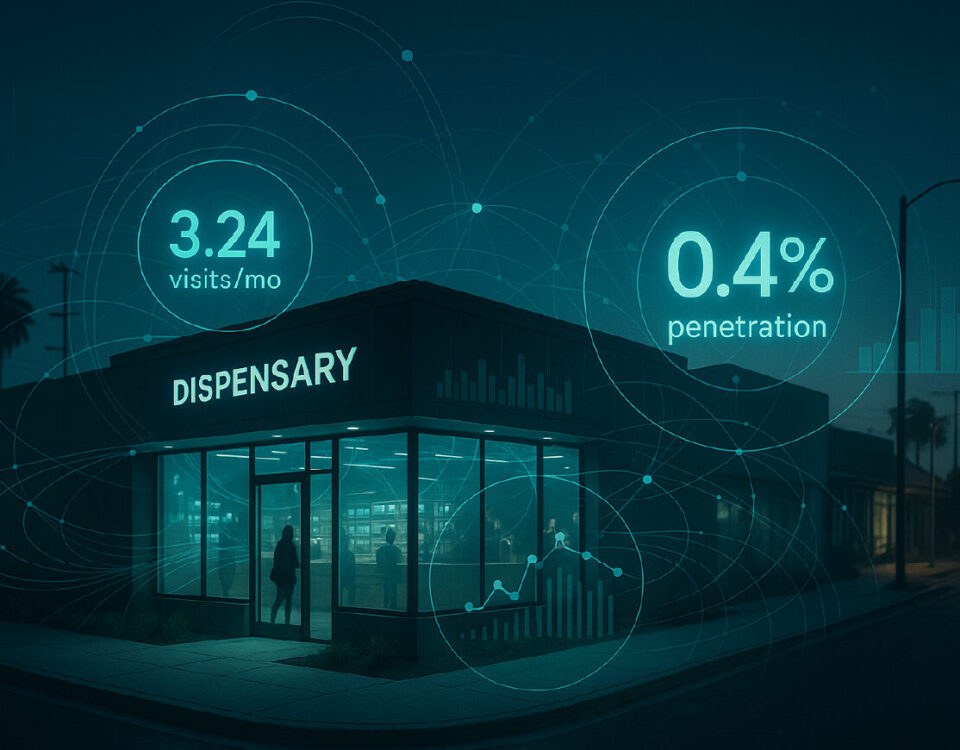The Apoc-Eclipse’s Shining on Oregon’s Cannabis Market

Cannabis Case Study: Promoting Business Diversity Differently
March 24, 2018
Predicting the Boom Out of California’s Market
March 24, 2018By Beau Whitney, Senior Economist of New Frontier Data
What We Have Learned: Approximately 1 million visitors traveled to Oregon for the August 2017 total solar eclipse, spiking demand for cannabis.
August 18, 2017 — With just days to go before the August 21 total solar eclipse, Oregon finds itself in the final throes of preparation for when a 65-mile-wide swath of darkness shall extend west to east across parts of 14 states. While the duration of the eclipse will only last about 2.5 minutes in any one location, and take all of about 90 minutes to sweep across the nation overall, some people have been anticipating it for years, and solidifying plans and reservations months ahead.
For the nascent cannabis industry, however, it may well provide a far-reaching case study about supply chain management. It is a business component which is rarely discussed in the cannabis segment, but one which as a practical proposition can drive so much cost out of a company’s operation if they know where they are sitting in terms of factors including energy costs, production schedule, inventory supplies, and consumer confidence in their continuity of supply.
New Frontier Data estimates that within the legalized cannabis industry’s current U.S. retail forecast of $6 billion for 2017, supply chain management represents an ancillary component worth approximately $3 billion a year nationwide. That fact is often underappreciated, but what cannot be overstressed is how important an effective and resilient supply chain is for the health and future of the industry and its operators. Big suppliers realize this already (think Scotts Miracle-Gro, Monsanto, etc.), but the industry at large needs to catch up. Bringing in supply chain best practices can increase revenues and profits. Once added up, those are factors which ultimately can make the difference between who has made a livelihood out of a hobby, versus making their business a $10 million to $100 million operation.
Per Monday’s eclipse, there are about 12.3 million Americans who live within the path of totality, and projected estimates for travelers nationwide range from 1.9 million to 7.4 million, as calculated by GreatAmericanEclipse.com. Those numbers suggest lots of logistical problems. For instance, what some predict as the “biggest driving distraction of the century” will see 50x more cars on American roads since the last U.S. coast-to-coast total eclipse occurred in 1918.
According to NASA, the eclipse will start with landfall at 10:15 a.m. PDT in Oregon, which also happens to be the only state along the 14-state path of totality where adult use cannabis is legal. Approximately 1 million people and 250,000 additional vehicles are expected to travel eagerly within the Beaver State for it, swelling its population by 24.4% almost literally overnight, and likely overwhelming the local infrastructure and services of small towns like Spray (population 160), where some residents expect to cater to thousands of visitors despite limited resources and a tiny working adult population.
Concerns there include the town’s running out of water, figuring where the incoming throngs will park (there’s only one main street in town), and how to provide for other basics like food, gas, cellphone service, and first aid or ambulatory care. Many neighboring towns and public agencies are undertaking an outlay of money that their local budgets did not have, with little guarantee that they’ll recoup their costs. Spray has a GoFundMe campaign to help cover $13,000 it spent simply to rent 94 porta-potties. The Oregon Department of Emergency Management is warning people to pack hand sanitizer, and even personal toilets, as the jammed thoroughfares are likely to impede proper septic servicing and cleaning of strained facilities whether at public rest stops or private facilities.
Hertz has cancelled car reservations booked months ahead, disappointing tourists who had spent months planning their trips. In eastern Oregon, temporary cell towers are being brought in to try to handle the increased cellular demand. Some gas stations are already out of fuel, and restaurants anticipate running out of food.
Likewise, swollen demand is also expected for sales of cannabis and alcohol. Many cannabis shops have already been reporting a spike in sales, and the Portland Oregonian newspaper saw fit to publish a statewide guide to dispensaries. Ironically, however, many retailers are as nervous as they are excited about the opportunity for record sales.
As exciting and romantic a notion to onlookers as an eclipse may be (presuming a clear sky, that is), the experience for retailers will all boil down to supply chain management. Oregon’s state government has closed courtrooms, its department of revenue is not taking cannabis tax appointments, and some banks and armored car services are either closing or postponing services. While still likely something short of Armageddon, the fallout looks to have a much more significant an impact than did the widespread paranoia about Y2K, when the arrival of the new millennium was met with largely overblown fears about a systemic crashing of the nation’s computing infrastructure.
Worries within Oregon’s cannabis industry are much more grounded for the eclipse. A million tourists equate conservatively to between 70,000 or 100,000 additional cannabis consumers. Certainly, those cannabis business operators who had the foresight and means brought on more inventory. Nevertheless, trying to accommodate so many additional consumers still foretells major supply-chain issues on the back end.
Maps Credit Union – Oregon’s major financial services provider supporting the cannabis industry – is closing for the day, thus preventing cannabis businesses from depositing record cash receipts from weekend sales swelled by the massive surge in demand. Similarly, armored car services are requesting re-scheduling to push out money pick-ups to Tuesday instead of Monday. The state tax office is not setting appointments Monday, meaning those businesses that want to pay their taxes in cash have to hold onto it for another day. With clogged roads and an overburdened communications system piled atop retailers’ having hoarded cash on hand, businesses are exposed and must have emergency/contingency plans in place to address the increased risks.
In Oregon’s case, the singular event is impacting transportation, banking, taxes, supply, security and communications. Being organized with tight control over one’s supply chain can be the difference between realizing increased profits, or being out of luck – i.e., out of stock.
Cannabis businesses nationwide face a number of related supply chain issues beyond those faced in Oregon. Regulatory, quality, raw material, and other packaging supply, forecasting, and logistics issues all must be evaluated, addressed, and planned for in order to be successful.
One common complaint from suppliers, retailers and customers alike, regardless of which state, is maintaining a continuity of supply. Hawaii just saw a bottleneck. As Alaska tried rolling out its adult use market, the industry was faced with chronic supply shortages. As a result, retailers were bidding up prices and offering to buy entire harvests from growers. State tax revenues were impacted and many retailers had to close their businesses until they could get more supply. The Washington market faced a test capacity constraint when it initially rolled out its program, with prices increased upwards of $30/gram, driving consumers back to the illicit market. When Oregon adopted new packaging rules, the regulators did so inside the material lead times, and suppliers had to expedite their packaging materials from China – adding costs and interrupting supply. Nevada did not have enough supply in the channel to support the increased demand when the adult use program was enacted.
In the end, those equipped with the most supply became kings for the day. Interruptions of supply and subsequent material shortages are day-to-day occurrences in virtually every legal cannabis market across the U.S. Those businesses that have a strong supply chain management team will be the ones who take advantage of opportunities (like Oregon’s) and maximize their revenues while capturing the best market share.
Most such issues can be mitigated to a certain extent through prudent planning. Supply chain management can improve internal communications and forecasting, and help drive operational efficiencies. With a focus on inventories, forecasting and controls, the risk of material stock outages is reduced. The fewer of those, the greater and more predictable the supply to customers and retailers; once customers and retailers understand that supply is reliably available from one source while products go lacking elsewhere, the more likely their regular patronage. Supply chain management is a team effort, but once the processes are in place, the organization can focus on other issues rather than continually putting out familiar fires and managing chronic crises.
Over the long term, supply chain management will be a key differentiator as the global cannabis market matures. Meanwhile, in Oregon this weekend and Monday, the big winners will be those who have developed contingencies, and can best execute those plans. They have the chance to take advantage of literally a once-in-a-lifetime opportunity. It represents a chance to distance themselves from the rest of the pack, and bank a record windfall.
The microcosm can be instructive for the rest of the U.S. market: Focus and investment toward tools and processes to optimize the supply chain will pay huge dividends in the future. If it was an aspect which few within the cannabis industry much talked about before, anecdotes from the “Apoc-Eclipse” may prove, like the return of sunlight, to bring a renewed appreciation of the importance which supply chain management plays for the future of the cannabis industry.
BTW, the next total eclipse in the U.S. is due on April 8, 2024, when the path of totality will extend through a dozen states and several major cities from Texas to New Hampshire.

Beau Whitney, Senior Economist of New Frontier Data
Beau Whitney is the Senior Economist for New Frontier Data. Whitney has a unique blend of high tech business operations skills, economics and pollical analysis, as well as cannabis industry experiences.
While at Intel and TriQuint Semiconductor, Whitney honed his business operations skills associated with quickly ramping products from low volume to high volume. This is a skill he has since transferred to the cannabis industry. He is the former chief operations officer and compliance officer of one of the largest vertically integrated, publicly traded cannabis company in North America. His experiences incorporated growing, extraction, edible manufacturing and wholesale and retail distribution operations.
As an economic and policy analyst, his Whitney Economics white papers analyzing the cannabis market have been referenced in Forbes Magazine, USA Today, as well as in cannabis industry publications and across the Associated Press wire. Whitney has provided policy recommendations at the state and national levels and is considered an authority on cannabis economics.




